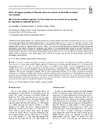Please use this identifier to cite or link to this item:
https://accedacris.ulpgc.es/jspui/handle/10553/9675
| Title: | Effect of organic exudates of Phaeodactylum tricornutum on the Fe(II) oxidation rate constant | Other Titles: | Efecto de los exudados orgánicos de Phaeodactylum tricornutum en la constante de velocidad de oxidación del Fe(II) | Authors: | González González, Aridane Santana-Casiano, J. Magdalena González-Dávila, Melchor Pérez Almeida, María Norma |
UNESCO Clasification: | 251002 Oceanografía química | Keywords: | Fe(II) Oxidation Organic exudates Diatom Oxygen, et al |
Issue Date: | 2012 | Journal: | Ciencias Marinas | Abstract: | Fe(II) oxidation kinetics were studied in seawater and in seawater enriched with exudates excreted by Phaeodactylum tricornutum\nas an organic ligand model. The exudates produced after 2, 4, and 8 days of culture at 6.21 .. 107, 2.29 .. 108, and 4.98 .. 108 cell L?1 were\nselected. The effects of pH (7.2?8.2), temperature (5?35 ºC), and salinity (10?36.72) on the Fe(II) oxidation rate were studied. All the data were\ncompared with the results for seawater without exudates (control). The Fe(II) rate constant decreased as a function of culture time and cell\nconcentration in the culture at different pH, temperature, and salinity. All the experimental data obtained in this study were fitted to a\npolynomial function in order to quantify the fractional contribution of the organic exudates from the diatoms to the Fe(II) oxidation rate in\nnatural seawater. Experimental results showed that the organic exudates excreted by P. tricornutum affect Fe(II) oxidation, increasing the\nlifetime of Fe(II) in seawater. A kinetic model approach was carried out to account for the speciation of each Fe(II) type together with its\ncontribution to the overall rate. Phaeodactylum tricornutum como modelo de ligando orgánico. Se seleccionaron los exudados producidos después de 2, 4 y 8 días de cultivo,\ncorrespondientes a 6.21 .. 107, 2.29 .. 108 y 4.98 .. 108 células L?1. Se estudió el efecto del pH (7.2?8.2), la temperatura (5?35 ºC) y la\nsalinidad (10?36.72) en la velocidad de oxidación del Fe(II). Todos los datos se compararon con los resultados obtenidos en agua de mar sin\nexudados (control). La constante de velocidad de oxidación del Fe(II) disminuyó en función del tiempo de cultivo y la concentración de células\na diferentes valores de pH, temperatura y salinidad. Todos los datos experimentales obtenidos en este estudio se ajustaron a una función\npolinómica con el objetivo de cuantificar la contribución parcial de los exudados orgánicos de diatomeas a la velocidad de oxidación del Fe(II)\nen agua de mar. Los resultados experimentales mostraron que los exudados orgánicos excretados por P. tricornutum afectan a la oxidación del\nFe(II) incrementando su tiempo de vida media en agua de mar. Se aplicó un modelo cinético para calcular la especiación de Fe(II) y la\ncontribución de cada especie a la velocidad total del proceso de oxidación. |
URI: | https://accedacris.ulpgc.es/handle/10553/9675 | ISSN: | 0185-3880 | DOI: | 10.7773/cm.v38i1B.1808 | Source: | Ciencias Marinas [ISSN 0185-3880], v. 38 (1B), p. 245-261 | Rights: | by-nc-nd |
| Appears in Collections: | Artículos |
SCOPUSTM
Citations
16
checked on Jun 8, 2025
WEB OF SCIENCETM
Citations
15
checked on Jun 8, 2025
Page view(s)
101
checked on May 11, 2024
Download(s)
162
checked on May 11, 2024
Google ScholarTM
Check
Altmetric
Share
Export metadata
Items in accedaCRIS are protected by copyright, with all rights reserved, unless otherwise indicated.
